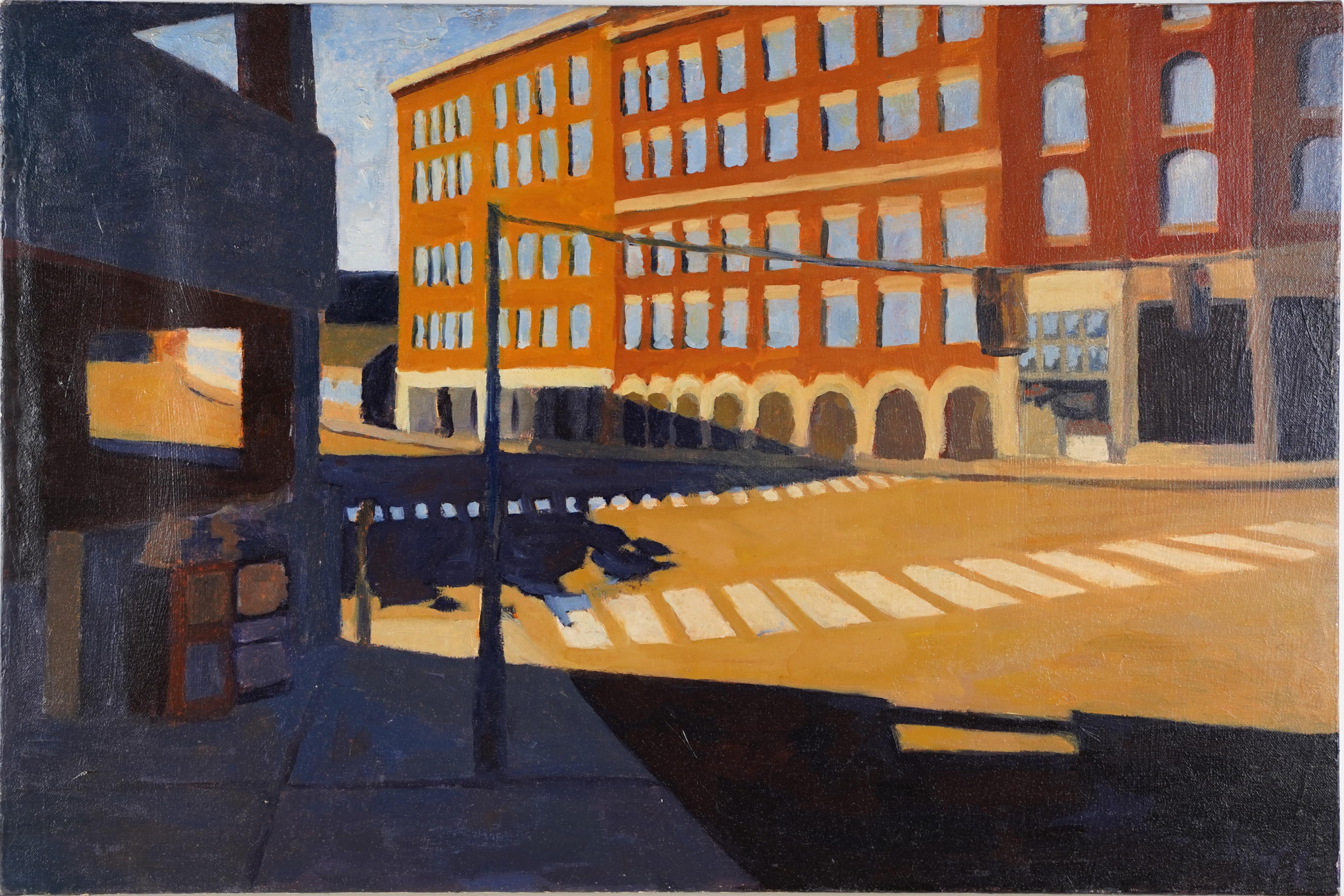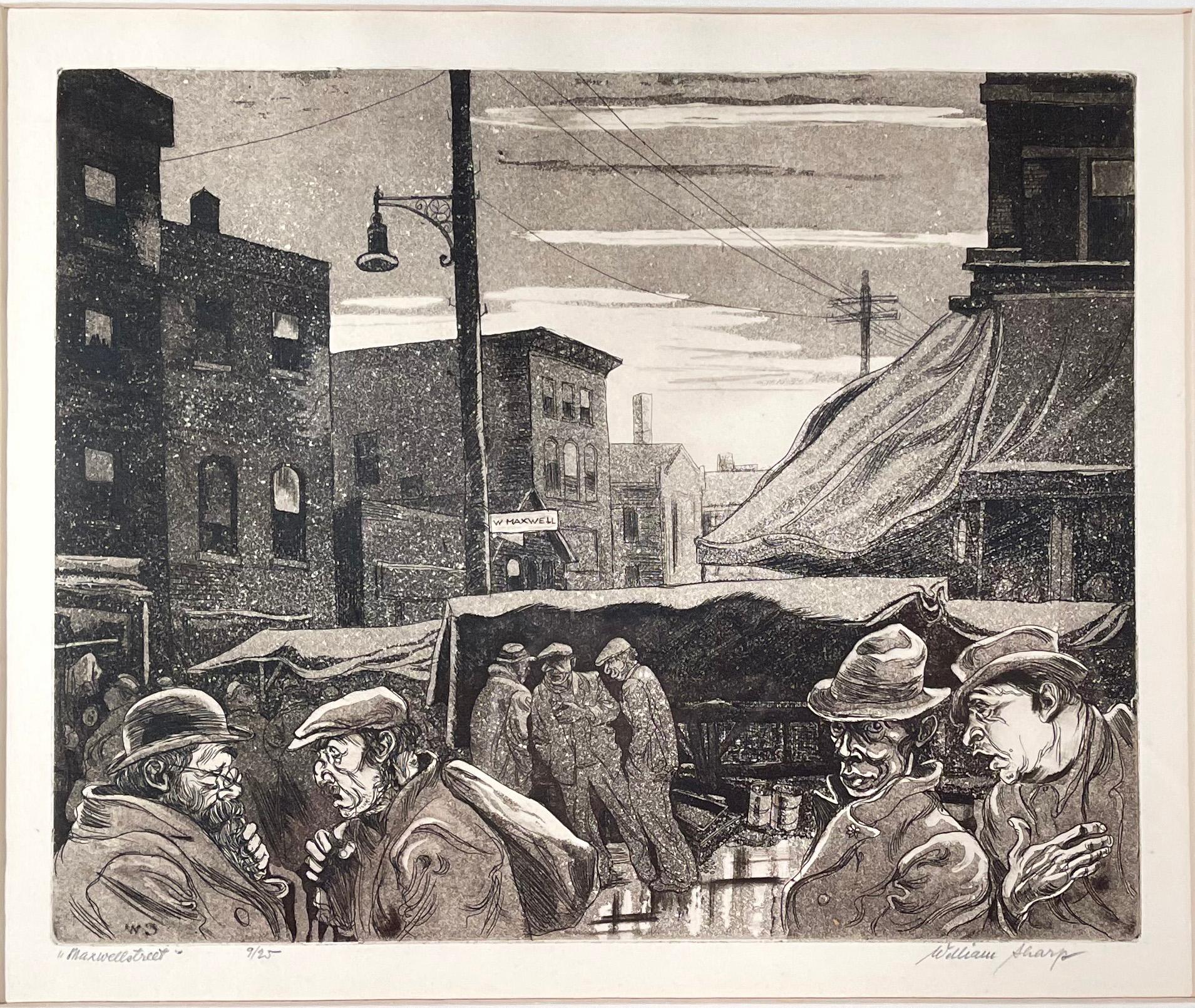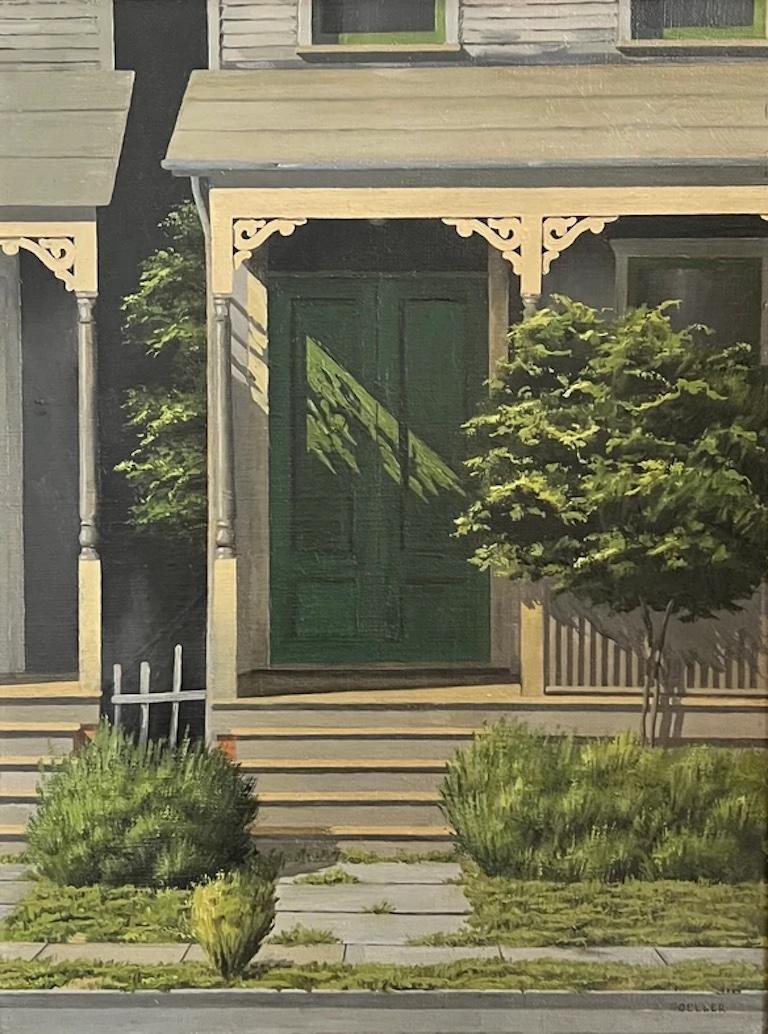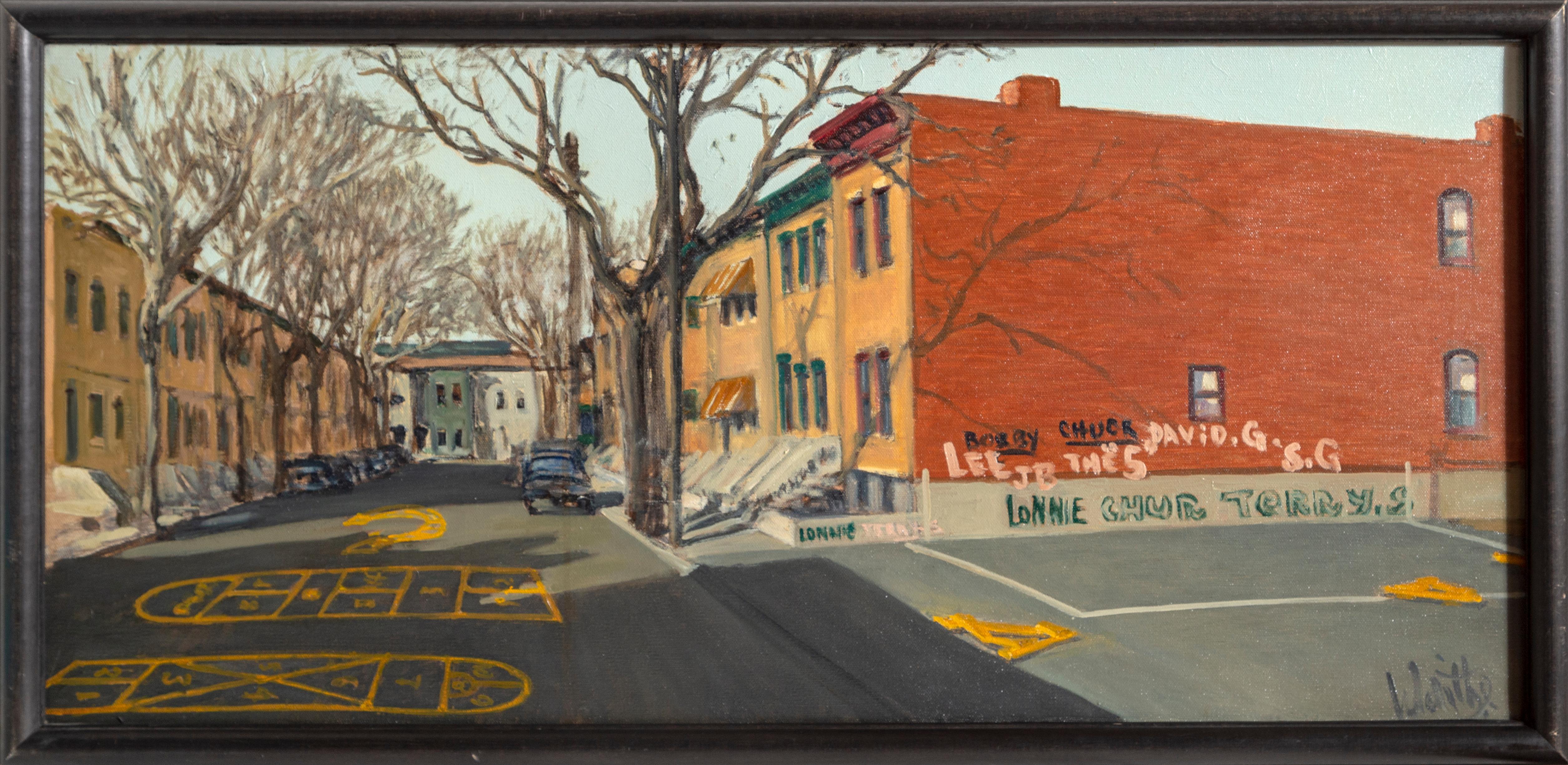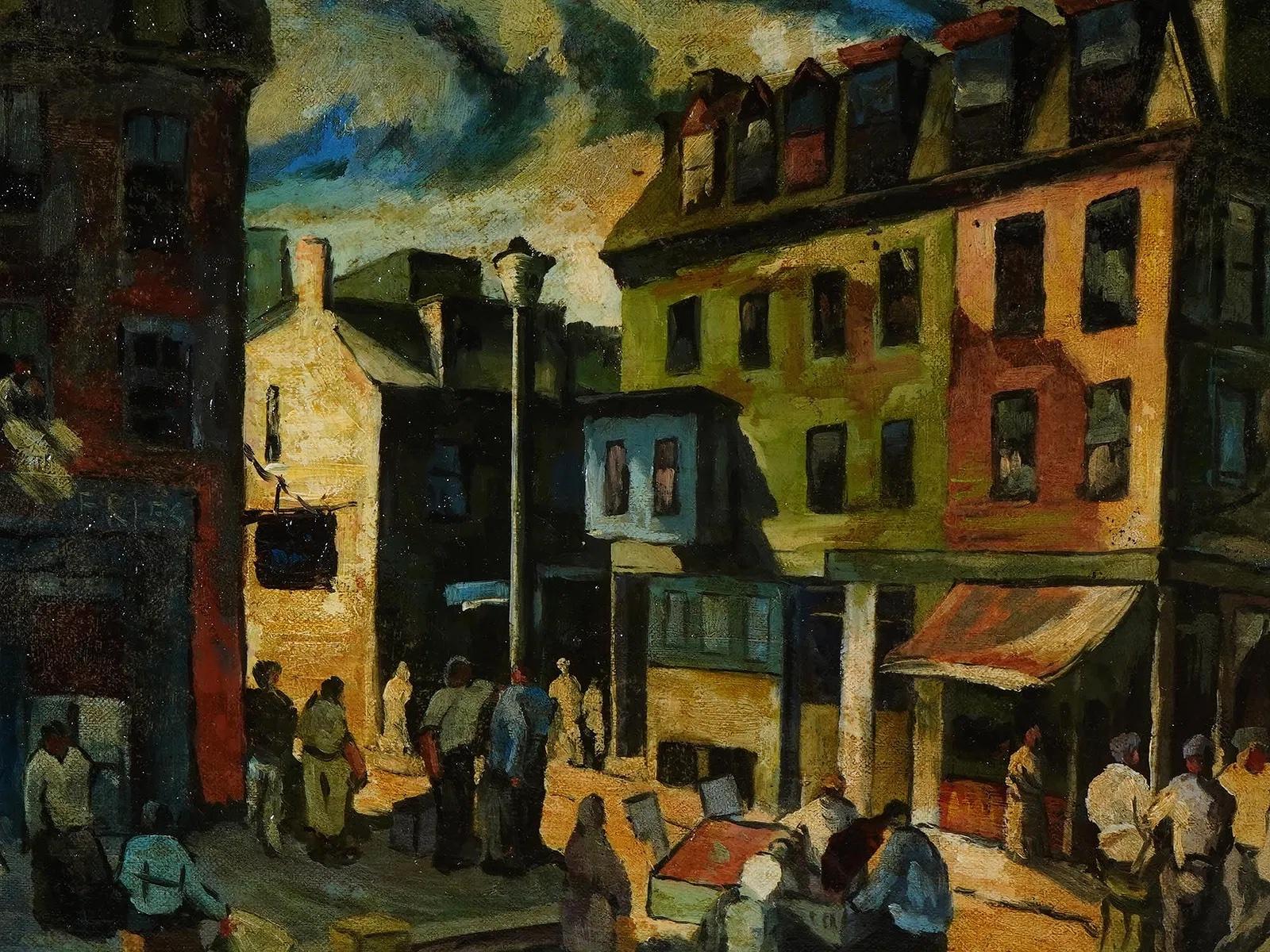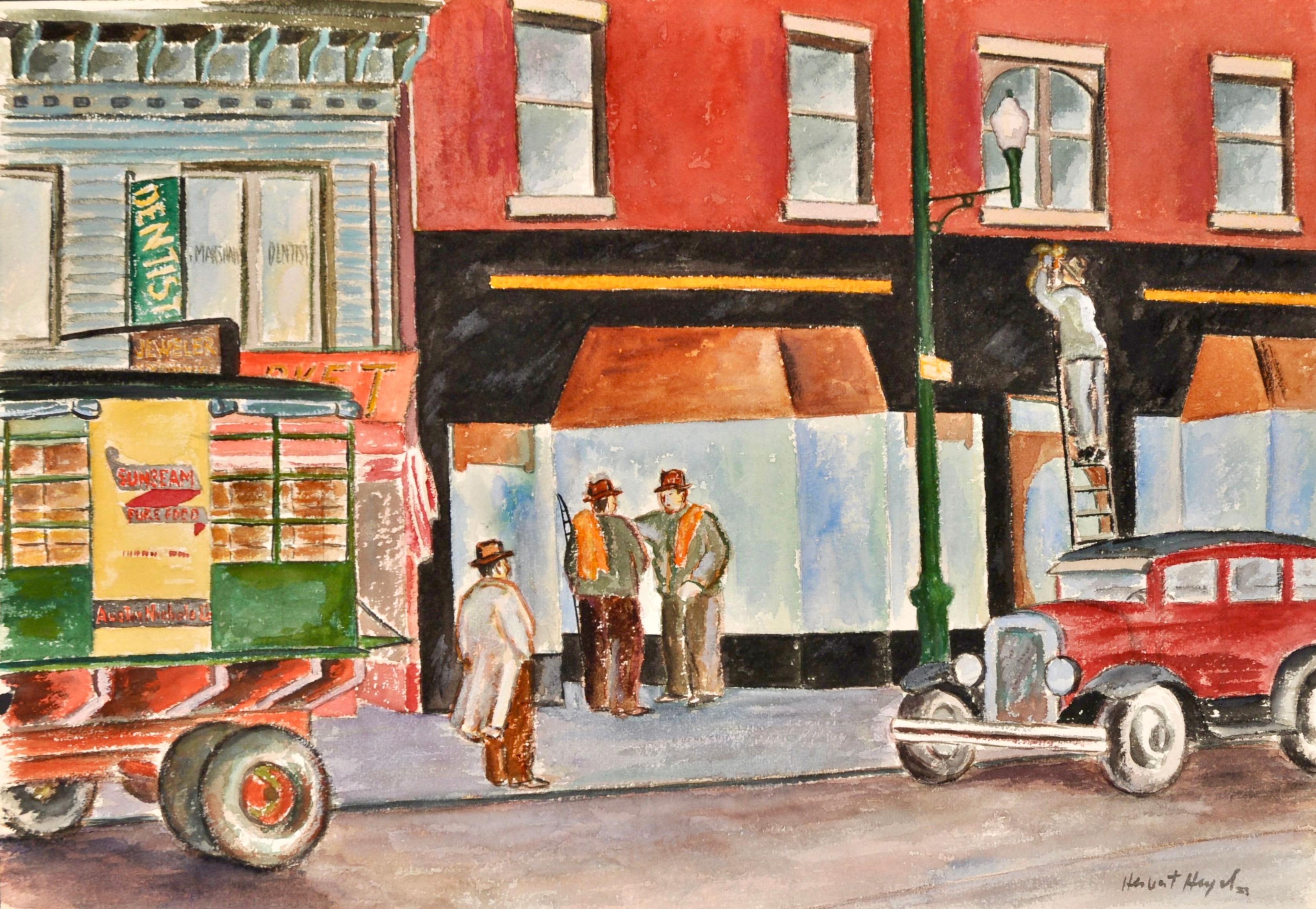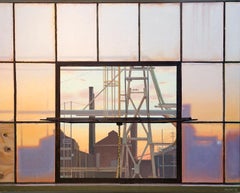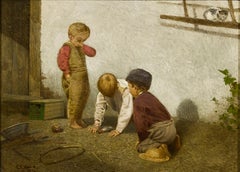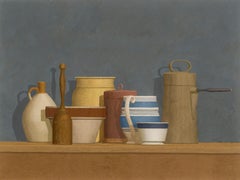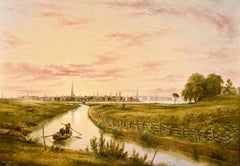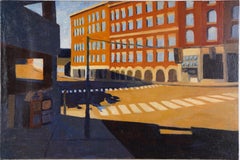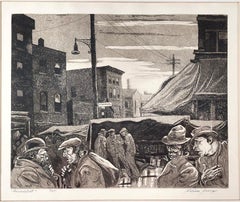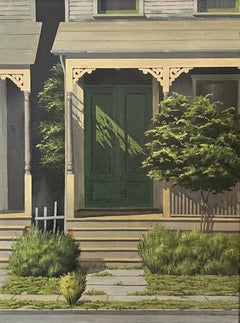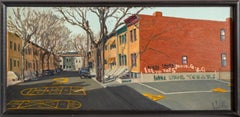Items Similar to Street Scene: "King George Dies"
Want more images or videos?
Request additional images or videos from the seller
1 of 5
Thomas FransioliStreet Scene: "King George Dies"1952
1952
$14,000
£10,677.16
€12,302.86
CA$19,998.64
A$21,986.23
CHF 11,365.02
MX$263,079.27
NOK 143,480.86
SEK 134,517.31
DKK 91,884.66
About the Item
Fransioli was born in Seattle, Washington, and received a degree in architecture from the University of Pennsylvania in 1930. He worked with John Russell Pope on plans for the exhibition galleries at the National Gallery of Art in Washington, D.C., which he pinpointed as the beginning of his interest in painting. World War II interrupted a promising career in architecture. Fransioli served in the Pacific Theatre from 1943 until 1946, and was among the first American soldiers to survey Hiroshima after the atomic bomb’s detonation in August 1945. He returned to civilian life and took up painting, basing himself in Boston, but working up and down the eastern seaboard.
Thomas Fransioli’s cityscapes are crisp and tidy. Buildings stand in bold outline, their forms squarely defined by stark light and long shadows. Saturated color permeates every corner of his canvases, from vibrant oranges and greens to smoky terra cottas and granites. Even the trees that line Fransioli’s streets, parks, and squares are sharp and angular, exactly like those in an architect’s elevation rendering. But Fransioli’s cities often lack one critical feature: people. His streets are largely deserted, save for parked cars and an occasional black cat scurrying across the pavement. People make rare appearances in Fransioli’s compositions, and never does the entropy of a crowd overwhelm their prevailing sense of order and precision. People are implied in a Fransioli painting, but their physical presence would detract from the scene’s bleak and surreal beauty.
Magic Realism neatly characterizes Fransioli’s artistic viewpoint. The term was first broadly applied to contemporary American art in the 1943 Museum of Modern Art exhibition, American Realists and Magic Realists. As exhibition curator Dorothy Miller noted in her foreword to the catalogue, Magic Realism was a “widespread but not yet generally recognized trend in contemporary American art…. It is limited, in the main, to pictures of sharp focus and precise representation, whether the subject has been observed in the outer world—realism, or contrived by the imagination—magic realism.” In his introductory essay, Lincoln Kirstein took the concept a step further: “Magic realists try to convince us that extraordinary things are possible simply by painting them as if they existed.”
This is Fransioli, in a nutshell. His cityscapes exist in time and space, but certainly not in the manner in which he portrays them.
Fransioli—and other Magic Realists of his time—was also the heir to Precisionism, spawned from Cubism and Futurism after the Great War and popularized in the 1920s and early 1930s. While Fransioli may not have aspired to celebrate the Machine Age, heavy industry, and skyscrapers in the same manner as Charles Sheeler, his compositions tap into the same rigid gridwork of the urban landscape that was first codified by the Precisionists.
During the 1950s, Fransioli was represented by the progressive Margaret Brown Gallery on Newbury Street in Boston, and then later by Kennedy Galleries in New York. His work was the subject of a retrospective of about 50 pictures at the Farnsworth Museum in Rockland, Maine, in 1954. Today, Fransioli’s work can be found in the collections of the Museum of Fine Arts, Boston; the Currier Gallery, Manchester, New Hampshire; the Nelson-Atkins Gallery, Kansas City, Missouri; the Seattle Art Museum; and in a number of important private art collections.
- Creator:Thomas Fransioli (1906 - 1997, American)
- Creation Year:1952
- Dimensions:Height: 8.25 in (20.96 cm)Width: 6.25 in (15.88 cm)Depth: 1.5 in (3.81 cm)
- Medium:
- Movement & Style:
- Period:
- Condition:
- Gallery Location:New York, NY
- Reference Number:Seller: APG 8189.011stDibs: LU235996952
About the Seller
5.0
Recognized Seller
These prestigious sellers are industry leaders and represent the highest echelon for item quality and design.
Established in 1952
1stDibs seller since 2010
35 sales on 1stDibs
Typical response time: 22 hours
Associations
Art Dealers Association of America
- ShippingRetrieving quote...Shipping from: New York, NY
- Return Policy
Authenticity Guarantee
In the unlikely event there’s an issue with an item’s authenticity, contact us within 1 year for a full refund. DetailsMoney-Back Guarantee
If your item is not as described, is damaged in transit, or does not arrive, contact us within 7 days for a full refund. Details24-Hour Cancellation
You have a 24-hour grace period in which to reconsider your purchase, with no questions asked.Vetted Professional Sellers
Our world-class sellers must adhere to strict standards for service and quality, maintaining the integrity of our listings.Price-Match Guarantee
If you find that a seller listed the same item for a lower price elsewhere, we’ll match it.Trusted Global Delivery
Our best-in-class carrier network provides specialized shipping options worldwide, including custom delivery.More From This Seller
View AllSixth Hour
By John Moore
Located in New York, NY
Signed and dated (at lower right): MOORE '19
Category
2010s Contemporary Paintings
Materials
Canvas, Oil
$40,000
His Only Pet
Located in New York, NY
Charles Caleb Ward was born in St. John, New Brunswick, Canada, the grandson of a New York Ward who had left for New Brunswick around the time of th...
Category
Late 19th Century American Realist Paintings
Materials
Oil, Board
Still Life - Niccone
Located in New York, NY
William Bailey’s still life paintings present seemingly everyday objects, including bowls, pitchers, and cups, in groupings that conjure the familiar world while offering a metaphysi...
Category
20th Century Contemporary Still-life Paintings
Materials
Paper, Casein
New York from Hoboken
By William Rickarby Miller
Located in New York, NY
Signed (at lower left): W.R. Miller/ 1851
Category
Mid-19th Century American Realist Landscape Paintings
Materials
Canvas, Oil
Brookside
Located in New York, NY
Signed (at lower right): C A Walker
Category
Late 19th Century American Realist Landscape Prints
Materials
Monotype
Old Country Bazaar
By William S. Schwartz
Located in New York, NY
Oil on canvas, 36 x 42 in.
Signed, dated, and inscribed (at lower right): WILLIAM S. SCHWARTZ 1926; (on the back): “OLD COUNTRY BAZAAR” / BY / WILLIAM S. SCHWARTZ / 1926
RECORDED: C. H. Bonte, “122nd Annual opens at Pennsylvania Academy,” in The Philadelphia Inquirer, Jan. 30, 1927
EXHIBITED: The Art Institute of Chicago, 1926, The Thirty-Ninth Annual Exhibition of American Paintings and Sculpture, no. 174 // The Pennsylvania Academy of the Fine Arts, Philadelphia, 1927, The One-Hundred-and-Twenty Second Annual Exhibition, p. 37 no. 181 // The Chicago Culture Club...
Category
20th Century American Modern Paintings
Materials
Canvas, Oil
You May Also Like
Antique American Modernist Street Scene Vintage Original Oil Painting
Located in Buffalo, NY
Vintage American school modernist cityscape painting. Oil on canvas, wrapped to board. No signature found.
Category
1950s Modern Landscape Paintings
Materials
Canvas, Oil
$1,356 Sale Price
20% Off
MAXWELL STREET
By William Sharp
Located in Portland, ME
Sharp, William (American, 1900-1961). MAXWELL STREET. Etching and aquatint, not dated, but circa 1940. Edition of 25, titled and signed in pencil and numbered 9/25. 8 5/8 x 10 3/4 in...
Category
1940s American Realist Landscape Prints
Materials
Etching, Aquatint
Across the Street
Located in Los Angeles, CA
This painting is part of our exhibition Charles Goeller: A Wistful Loneliness.
Oil on canvas, 16 x 12 inches, Signed lower right
Exhibited:
1) [Solo E...
Category
1940s American Modern Landscape Paintings
Materials
Oil, Canvas
Newark Street, Oil Painting by William Waithe
By William Waithe
Located in Long Island City, NY
Born in Harlem, William Waithe studied painting, drafting and architecture at New York University and Queens College. He was known for painting outdoors, and is particularly identifi...
Category
Late 20th Century American Realist Landscape Paintings
Materials
Oil
Cityscape Mid-20th Century Modern Social Realism American Scene Regionalism WPA
Located in New York, NY
Cityscape Mid-20th Century Modern Social Realism American Scene Regionalism WPA
Samuel Thal (1903 to 1964)
"Cityscene"
12 x 16 inches
Oil on board, c. 1940s
Signed verso
Framed: 19...
Category
1940s American Modern Figurative Paintings
Materials
Board, Oil
"Streetscape" American Scene WPA Social Realism Mid 20th Century Industrial
Located in New York, NY
"Streetscape" American Scene WPA Era Social Realism Mid 20th Century Industrial
Herbert Heyel (American 1907-2000)
"Streetscape"
14 x 20 inches
Watercolor on paper, c. 1939
Signed l...
Category
1930s American Realist Landscape Drawings and Watercolors
Materials
Paper, Watercolor
More Ways To Browse
Dior Street
Atomic Bomb
Atomic Bombs Used
Countryside Oil Painting
Dove Art
Children On Beach Oil Painting
London Landscape Painting
Seascape Original Oil Painting
St Louis Impressionist Paintings St Louis
Expressionist Oil Still Life
Italian Oil Paintings Of Naples
New York City Landscapes
Freedom Painting
Mid Century French Street Scene
Rural Landscape Art
Spanish Impressionist
Sunflower Painting
Tulip Painting
